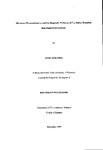Structural Characterisation and the Diagenetic Pathways of C25 Highly Branched Isoprenoid Hydrocarbons
| dc.contributor.author | Johns, Lesley Anne | |
| dc.contributor.other | School of Geography, Earth and Environmental Sciences | en_US |
| dc.date.accessioned | 2013-09-17T12:29:06Z | |
| dc.date.available | 2013-09-17T12:29:06Z | |
| dc.date.issued | 1999 | |
| dc.identifier | NOT AVAILABLE | en_US |
| dc.identifier.uri | http://hdl.handle.net/10026.1/1806 | |
| dc.description.abstract |
Highly branched isoprenoid (HBI) hydrocarbons have been widely reported in recent sediments. It is known that two species of diatomaceous algae, the diatoms Haslea ostrearia and Rhizosolenia setigera are able to biosynthesise C25 HBI alkenes. Large scale cultures of H. ostrearia studied previously, allowed isolation and characterisation of five HBI polyenes. The stereochemistry of the chiral centres was not reported however. The concentrations of HBIs often decrease with depth in sediment cores but the reasons for this are unknown. | |
| dc.language.iso | en | en_US |
| dc.publisher | University of Plymouth | en_US |
| dc.title | Structural Characterisation and the Diagenetic Pathways of C25 Highly Branched Isoprenoid Hydrocarbons | en_US |
| dc.type | Thesis | |
| plymouth.version | Full version | en_US |
| dc.identifier.doi | http://dx.doi.org/10.24382/1456 | |
| dc.identifier.doi | http://dx.doi.org/10.24382/1456 |
Files in this item
This item appears in the following Collection(s)
-
01 Research Theses Main Collection
Research Theses Main


